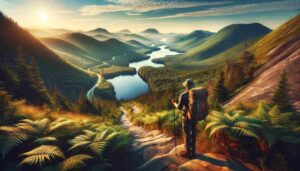I’m thrilled to share with you everything you need to know about hiking clubs for seniors. As a fellow hiking enthusiast, I understand the joy and fulfillment that comes from exploring nature’s beauty and challenging oneself on the trails. And guess what? Age is just a number when it comes to embracing this incredible outdoor activity!
In our later years, it becomes even more crucial to stay active, engaged, and connected to the world around us. Hiking clubs for seniors provide the perfect avenue to do just that. They offer an opportunity to meet like-minded individuals, experience the wonders of nature, and embark on unforgettable adventures. So, let’s dive into this guide and discover why joining a hiking club can be a life-changing decision for seniors like us. Lace-up your boots, and let’s hit the trail together!
What is a Hiking Club for Seniors?
A hiking club for seniors is a group of individuals in their golden years who share a common passion for hiking and exploring the great outdoors. These clubs provide a supportive and inclusive environment where seniors can come together to enjoy nature, engage in physical activity, and build lasting friendships.
The primary purpose of a hiking club for seniors is to create opportunities for outdoor adventures tailored to the abilities and preferences of older adults. These clubs organize regular hikes, ranging from leisurely walks on gentle trails to more challenging treks for the more adventurous members. The activities may also include day trips, overnight camping, and even multi-day excursions to breathtaking destinations.
What makes these clubs special is the sense of community they foster. Members of a hiking club for seniors often share a love for nature, a zest for life, and a desire to stay active and vibrant. Joining such a club opens the door to forming new connections, expanding social circles, and finding companions who share similar interests and goals.
In essence, a hiking club for seniors offers the perfect blend of physical activity, mental stimulation, and social interaction. It provides a supportive and encouraging environment where seniors can thrive and continue to enjoy the beauty and challenges that hiking has to offer. So, whether you’re a seasoned hiker or new to the trails, these clubs welcome individuals of all skill levels, ensuring that everyone can find their perfect hiking experience.
Why Should Seniors Join a Hiking Club?
You might be wondering why joining a hiking club specifically designed for seniors is beneficial. Well, let me assure you, there are numerous reasons why becoming a part of such a club can be a game-changer for your physical, mental, and social well-being. Here are 6 compelling reasons to consider.
- Health and Fitness: Hiking is an excellent form of exercise that offers a wide range of health benefits. By joining a hiking club, you’ll have a regular and structured opportunity to engage in physical activity. Hiking helps improve cardiovascular health, strengthen muscles and bones, enhance balance and coordination, and boost overall fitness. It’s a fun and enjoyable way to stay active, maintain mobility, and promote a healthy lifestyle.
- Connection with Nature: Spending time in nature has a profound impact on our well-being. Hiking allows you to immerse yourself in the beauty of natural landscapes, breathe in fresh air, and experience the sights, sounds, and scents of the great outdoors. It provides a refreshing escape from the hustle and bustle of everyday life, offering a sense of peace, tranquility, and rejuvenation.
- Social Engagement: One of the greatest joys of joining a hiking club for seniors is the opportunity to connect with like-minded individuals who share your passion for outdoor adventures. These clubs foster a sense of camaraderie, where you can forge new friendships, share experiences, and create lasting memories. Hiking together allows you to bond with fellow hikers, exchange stories, and support each other along the trails.
- Learning and Growth: Hiking clubs often organize educational sessions, workshops, and guest speakers who share their expertise on various aspects of hiking and outdoor exploration. These learning opportunities can expand your knowledge of local flora and fauna, trail safety, navigation skills, and more. Engaging in continuous learning keeps your mind sharp and adds depth to your hiking experiences.
- Adventure and Exploration: Joining a hiking club opens the door to exciting adventures and exploration. You’ll have the chance to discover new trails, visit stunning landscapes, and embark on journeys that may have seemed daunting alone. The club’s organized trips and hikes allow you to explore places you might not have considered on your own, expanding your horizons and creating unforgettable experiences.
- Support and Safety: Hiking clubs provide a supportive environment, especially for seniors who may have specific concerns or limitations. The group dynamic ensures that you’re not alone on the trails, with fellow members offering assistance, encouragement, and companionship. Moreover, hiking clubs prioritize safety, often implementing guidelines and precautions to ensure everyone’s well-being during hikes.
In short, joining a hiking club for seniors combines the benefits of physical exercise, connection with nature, social interaction, personal growth, and safety. It’s a holistic approach to enjoying the outdoors, staying fit, and nurturing a sense of community.
Finding the Right Hiking Club
Finding the right hiking club for seniors requires some research and consideration. Here are a few tips to help you find a club that aligns with your interests, abilities, and goals:
- Local Clubs and Organizations: Start by researching local hiking clubs and organizations in your area. Check online directories, community bulletin boards, or contact local parks and recreation departments to gather information about clubs that cater specifically to seniors or have senior-friendly hiking programs.
- Club Focus and Activities: Consider the focus and activities of each club you come across. Some clubs may have a specific focus, such as leisurely walks, moderate hikes, or more challenging treks. Evaluate your own preferences and abilities to ensure that the club’s activities align with what you’re looking for.
- Difficulty Levels: Assess the difficulty levels of the hikes offered by each club. Some clubs may offer a variety of hikes, ranging from easy strolls to more strenuous trails. It’s important to find a club that caters to your fitness level and hiking experience. If you’re a beginner, look for clubs that offer introductory hikes or have a supportive approach for newcomers.
- Group Size: Consider the size of the hiking groups within each club. Some individuals prefer smaller groups for a more intimate and close-knit experience, while others enjoy the energy and dynamics of larger groups. Think about your own comfort level and the type of hiking experience you desire.
- Schedule and Frequency: Check the club’s schedule and the frequency of their hikes. Determine if their outing schedule fits your availability and if they offer hikes on days or times that work for you. Additionally, consider if you prefer regular weekly hikes, monthly trips, or a mix of both.
- Visit and Observe: Before making a final decision, visit a club and observe one of their hikes if possible. This will give you a firsthand experience of the club’s dynamics, the camaraderie among members, and the overall vibe. Take the opportunity to chat with club members and ask questions to get a better sense of what to expect.
- Club Culture and Values: Pay attention to the club’s culture and values. Look for clubs that prioritize inclusivity, respect for nature, and a supportive atmosphere. A club that fosters a positive and welcoming environment will enhance your overall experience and make you feel like a valued member.
Remember, finding the right hiking club is about finding a group that suits your needs, preferences, and hiking goals. Take your time, explore different options, and trust your instincts when making a decision. Being part of a hiking club that resonates with you will enrich your hiking adventures and create lasting connections with fellow hikers who share your love for the great outdoors.
Preparing for Hiking Trips
Preparing for hiking trips is essential to ensure a safe and enjoyable experience in the great outdoors. Here are 5 important considerations and tips to help you prepare:
1. Physical Preparation:
-
- Stay active: Engage in regular physical activity to build strength, endurance, and flexibility. Incorporate exercises that target your legs, core, and cardiovascular fitness.
- Start slowly: If you’re new to hiking or haven’t been active for a while, gradually increase your activity level to prevent injuries. Begin with shorter, easier hikes and gradually work your way up to more challenging ones.
- Consult with your doctor: If you have any health concerns or medical conditions, it’s advisable to consult with your doctor before starting a hiking regimen.
2. Gear and Equipment:
-
- Invest in proper footwear: Choose hiking shoes or boots that provide good support, traction, and comfort. Make sure they are broken in before hitting the trails to avoid blisters or discomfort.
- Dress in layers: Wear moisture-wicking and breathable clothing that can be layered to adapt to changing weather conditions. Don’t forget a hat, sunglasses, and sunscreen to protect yourself from the sun’s rays.
- Pack essentials: Carry a backpack with essentials such as a map, compass, water bottle, snacks, extra clothing layers, a first aid kit, a whistle, a flashlight, and a multi-tool. Pack according to the length and difficulty of the hike.
3. Research and Planning:
-
- Study the trail: Familiarize yourself with the trail you’ll be hiking. Look for information on the distance, elevation gain, difficulty level, trail conditions, and any specific features or landmarks.
- Check weather conditions: Stay updated on the weather forecast for the day of your hike. Be prepared for changes in weather and adjust your plans if necessary.
- Share your plans: Inform a family member or friend about your hiking plans, including the trail you’ll be on, estimated duration, and expected return time.
4. Hydration and Nutrition:
-
- Stay hydrated: Drink plenty of water before, during, and after your hike. Carry an adequate supply of water and consider a hydration bladder or water filter for longer hikes.
- Fuel your body: Pack nutritious snacks and meals to sustain your energy levels during the hike. Include a mix of carbohydrates, protein, and healthy fats to keep you fueled and satiated.
5. Safety and Etiquette:
-
- Hike with a buddy or group: Whenever possible, hike with a companion or join a hiking club. This ensures safety, companionship, and support along the trails.
- Leave no trace: Practice Leave No Trace principles, which involve minimizing your impact on the environment. Pack out all your trash, stay on designated trails, and respect wildlife and vegetation.
- Be aware of your surroundings: Stay vigilant on the trails, watch for hazards, and follow any safety signs or guidelines provided. If you encounter wildlife, maintain a safe distance and avoid feeding or approaching them.
Remember, proper physical conditioning, appropriate gear, research, and safety measures are all key to ensuring a successful and enjoyable hiking experience.
Understanding Hiking Etiquette
Understanding and practicing proper hiking etiquette is crucial for maintaining a positive and respectful environment on the trails. Here are some key guidelines to follow:
1. Respect Nature:
-
- Stay on designated trails: Stick to established paths to protect fragile ecosystems and prevent damage to vegetation.
- Leave no trace: Pack out all your trash and dispose of it properly. Minimize your impact by avoiding littering and leaving natural items undisturbed.
- Preserve flora and fauna: Avoid picking flowers or disturbing wildlife. Appreciate nature’s beauty without altering or harming it.
2. Yielding and Passing:
-
- Uphill has the right of way: If you encounter hikers going uphill while you’re going downhill, yield to them. It’s easier for hikers going uphill to maintain momentum.
- Step aside for faster hikers: If someone behind you is hiking at a faster pace, step aside at a wider section of the trail and allow them to pass safely.
- Communicate and be courteous: Use clear verbal cues or polite gestures to communicate with other hikers. Show respect, patience, and kindness to fellow trail users.
3. Group Hiking:
-
- Stay in smaller groups: If hiking with a large group, it’s best to split into smaller groups to minimize the impact on the trail and allow others to pass more easily.
- Avoid blocking the trail: When taking breaks or regrouping, move to the side of the trail to allow others to pass without obstruction.
4. Noise and Wildlife:
-
- Keep noise levels down: Respect the tranquility of nature by keeping voices and noises at a reasonable volume. Loud noises can disturb wildlife and other hikers seeking a peaceful experience.
- Observe wildlife from a distance: Maintain a safe distance from wildlife, and avoid approaching or feeding animals. Admire them from afar to minimize stress or disruption to their natural behavior.
5. Preparedness and Safety:
-
- Be prepared: Carry essential gear, including a map, compass, first aid kit, adequate water, and appropriate clothing and footwear.
- Follow safety guidelines: Observe any posted signs or regulations, such as warnings of potential hazards or closures due to weather conditions.
- Stay informed: Check weather forecasts before heading out and be prepared for changes in weather. Keep an eye on trail conditions and adjust your plans accordingly.
Remember, hiking etiquette is about showing respect, being mindful of others, and preserving the natural beauty of the trails. Enjoy your hikes and help create a harmonious atmosphere on the paths you explore.
Hiking Tips for Seniors
Hiking is a wonderful activity that can be enjoyed by seniors of all fitness levels. Here are 10 hiking tips specifically tailored to seniors to ensure a safe and enjoyable experience on the trails:
1. Start Slow and Gradually Increase the Difficulty
-
- Begin with shorter, easier hikes and gradually progress to longer or more challenging trails.
- Listen to your body and don’t push yourself beyond your comfort zone. It’s okay to take breaks and adjust the pace to accommodate your needs.
2. Know Your Limits and Choose Appropriate Trails
-
- Assess the difficulty level and terrain of the trail before embarking on a hike.
- Consider factors such as elevation gain, distance, and trail conditions to select hikes that match your fitness level and abilities.
3. Warm-Up and Stretch
-
- Before starting a hike, warm up your muscles with light exercises such as walking or gentle stretching.
- Focus on stretching your legs, hips, and shoulders to prepare them for the physical demands of hiking.
4. Use Proper Gear and Footwear
-
- Invest in supportive and comfortable hiking shoes or boots that fit well and provide good traction.
- Wear moisture-wicking and breathable clothing suitable for weather conditions. Dress in layers to adjust to temperature changes.
5. Hydration and Snacks
-
- Stay hydrated by drinking water regularly throughout the hike. Carry an adequate supply of water and sip frequently.
- Pack lightweight and nutritious snacks to keep your energy levels up. Trail mix, energy bars, and fresh fruits are good options.
6. Take Breaks and Pace Yourself
-
- Listen to your body and take breaks whenever needed. Resting allows you to regain energy and prevent overexertion.
- Pace yourself to maintain a comfortable and sustainable speed. It’s not a race, so enjoy the journey and savor the surroundings.
7. Use Hiking Poles for Stability
-
- Consider using hiking poles for added stability, especially on uneven or steep terrain.
- Hiking poles can help reduce strain on your joints, improve balance, and provide additional support during descents.
8. Be Prepared for Changes in the Weather
-
- Check the weather forecast before heading out and dress appropriately.
- Pack rain gear, extra layers, and sun protection (hat, sunglasses, sunscreen) to be prepared for unexpected weather changes.
9. Hike with a Companion or Group
-
- Hiking with a buddy or joining a hiking club can enhance safety and enjoyment. You can provide mutual support and share the experience together.
10. Listen to Your Body and Be Mindful of Safety
- Pay attention to any signs of fatigue, pain, or discomfort. Rest or turn back if necessary.
- Be cautious when navigating tricky or slippery sections of the trail. Take your time and use handholds or footholds when available.
Remember, hiking is about connecting with nature, staying active, and enjoying the journey. Embrace the experience at your own pace and relish the beauty of the great outdoors. Happy hiking!
Overcoming Hiking Challenges for Seniors
While hiking can be an incredibly rewarding experience for seniors, it’s important to address and overcome certain challenges that may arise. Here are 10 tips to help you overcome common hiking challenges:
1. Physical Limitations:
-
- Know your physical limitations and choose trails that match your fitness level.
- Focus on building strength, endurance, and flexibility through regular exercise and conditioning.
- Consider consulting with a healthcare professional or a personal trainer to develop a suitable exercise routine.
2. Joint Pain and Arthritis:
-
- Choose trails with moderate terrain and avoid steep or uneven surfaces that may exacerbate joint pain.
- Use trekking poles for added support and to reduce the impact on your joints.
- Consider wearing supportive footwear and using insoles or orthotics to alleviate joint pain.
3. Managing Discomfort or Pain:
-
- Listen to your body and take breaks as needed. Use rest stops to stretch, hydrate, and give your muscles and joints a break.
- Consider carrying over-the-counter pain relievers or anti-inflammatory medications in case of discomfort or pain.
- Utilize hot or cold packs to soothe sore muscles or joints after the hike.
4. Balance and Stability:
-
- Improve balance and stability through exercises such as yoga, tai chi, or balance training.
- Use trekking poles or walking sticks to provide extra stability and support on uneven terrain.
- Take your time when navigating tricky sections and choose your footing carefully.
5. Fear of Falling:
-
- Build confidence through regular hiking and gradually challenge yourself on more difficult trails.
- Use proper hiking footwear with good traction to reduce the risk of slipping.
- Hike with a buddy or join a hiking club to have support and reassurance during your hikes.
6. Hydration and Energy Management:
-
- Stay hydrated by drinking water regularly before, during, and after your hike.
- Conserve energy by taking frequent breaks, especially on longer or more strenuous hikes.
- Pack lightweight, nutritious snacks to maintain energy levels and replenish electrolytes.
7. Adapting to Altitude or Climate Changes:
-
- If hiking at high altitudes, acclimatize gradually to allow your body to adjust to the changes in oxygen levels.
- Dress in layers to accommodate temperature fluctuations and protect yourself from extreme weather conditions.
- Pay attention to any signs of altitude sickness, such as dizziness or shortness of breath, and descend if necessary.
Remember, it’s essential to listen to your body, know your limits, and make informed decisions.
Conclusion
As you conclude this comprehensive guide to hiking clubs for seniors, it’s clear that the great outdoors holds endless possibilities for adventure and connection. By joining a hiking club, you’ll not only embark on incredible journeys but also forge new friendships and embrace a vibrant and active lifestyle. So, lace up your boots, step onto the trails, and let the beauty of nature inspire and rejuvenate you. With each hike, you’ll discover the wonders of the world around you and the incredible strength within you. So, what are you waiting for? It’s time to embrace the joys of hiking and create memories that will last a lifetime.
Remember, hiking is not just about the destination—it’s about the journey. Take the time to appreciate the beauty around you, savor the fresh air, and let the trails guide you to new heights. Stay curious, keep exploring, and never stop embracing the active and fulfilling lifestyle that hiking offers.
Join a hiking club for seniors, meet fellow hikers, and forge new connections. Get ready to create lifelong memories, celebrate achievements, and experience the transformative power of nature. The trails are calling, and it’s time for you to answer. Happy hiking!
Related Article: Training For Hiking For Seniors: Conquer Hiking Adventures With Ease










